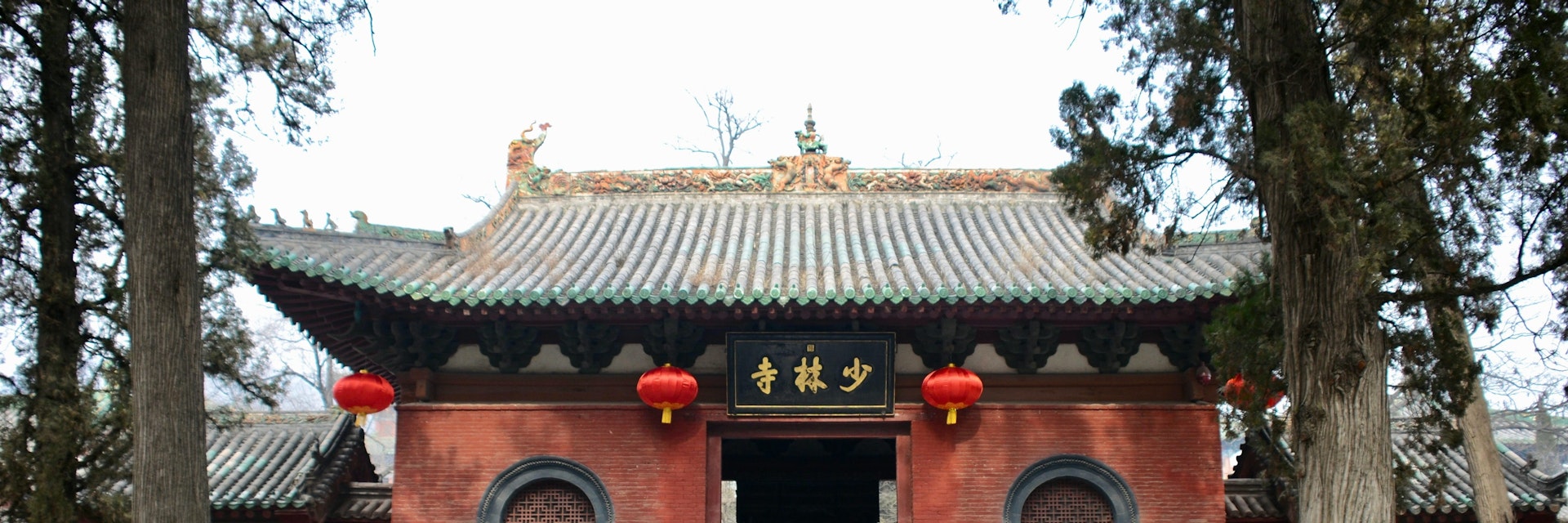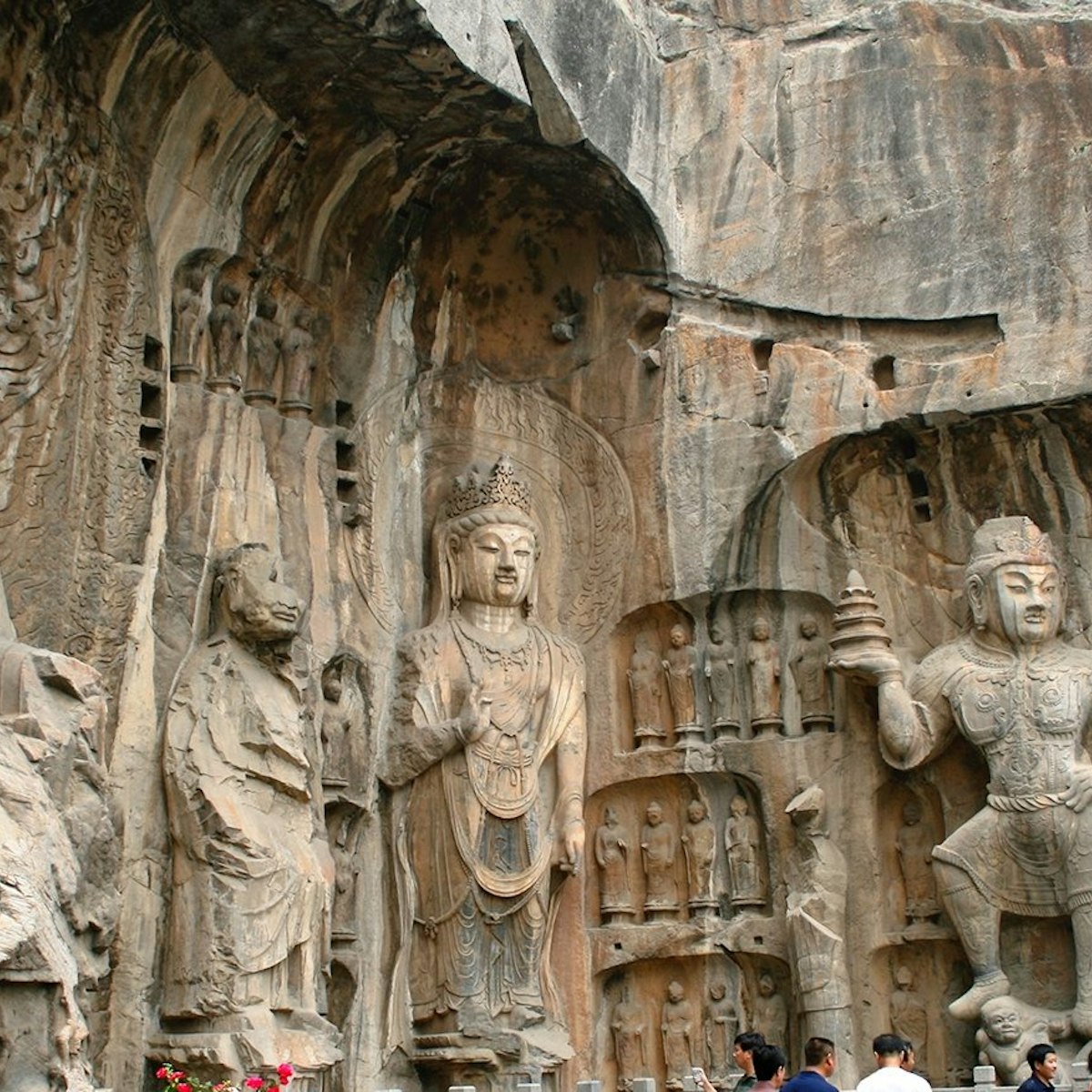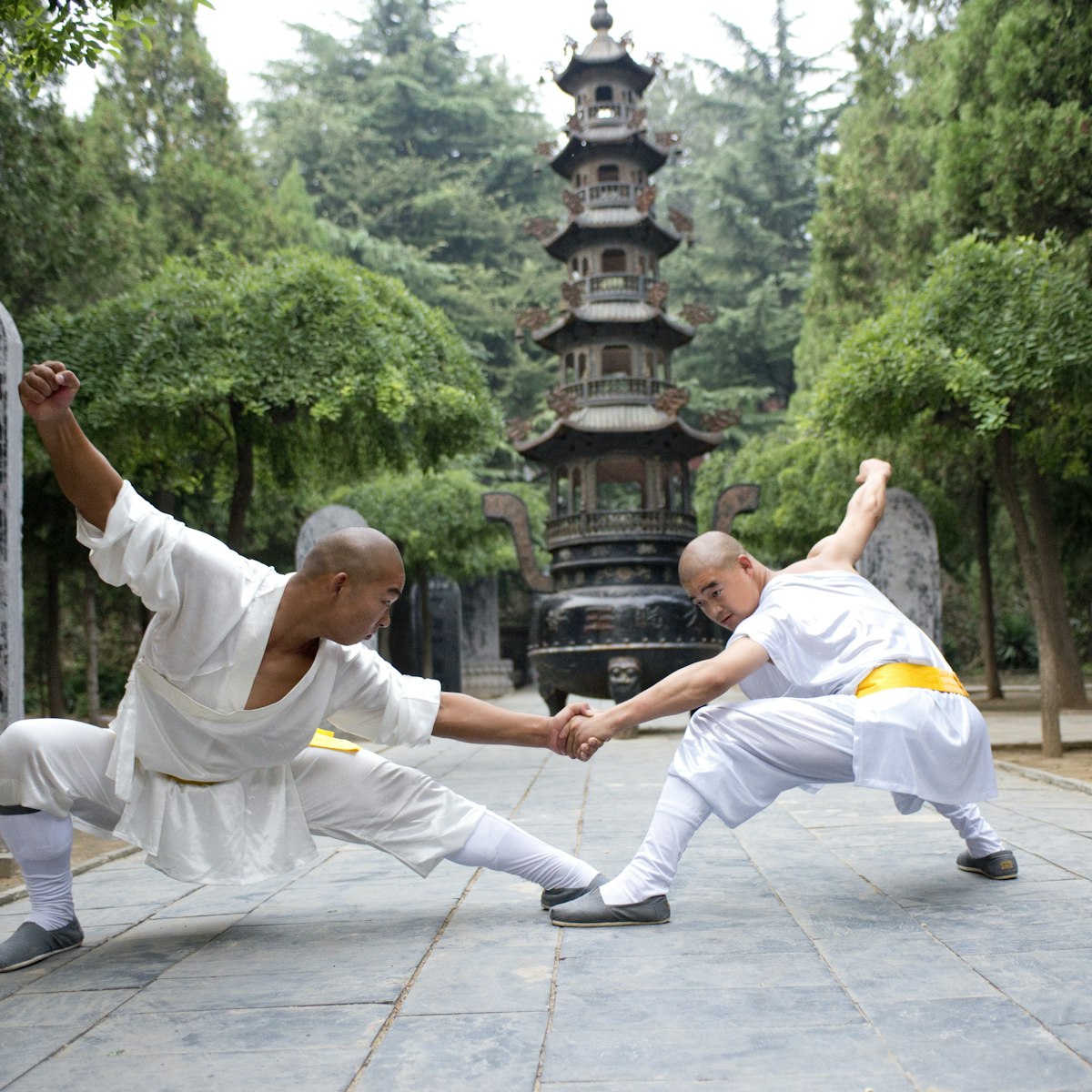The largely rebuilt Shaolin Temple is a commercialised victim of its own incredible success. A frequent target of war, the ancestral home of wǔshù was last torched in 1928, and the surviving halls – many of recent construction – are today assailed by relentless waves of selfie-shooting tour groups. The temple’s claim to fame, its dazzling gōngfū (kung fu) based on the movements of animals, insects and sometimes mythological figures, guarantees that martial arts clubs around the world make incessant pilgrimages.
A satisfying visit to the Shaolin Temple requires, rather than bestows, a Zen mentality (to handle the visiting hordes and looped recordings broadcast from competing loudspeakers). But if you explore away from the main areas, you could spend an entire day or two visiting smaller temples, climbing the surrounding peaks and eking out crumbs of solitude.
Coming through the main entrance, you’ll pass several wǔshù schools; the students practising in the red uniforms belong to Shaolin Tagou – the world's biggest gōngfū school. On the right, about 500m in, is the Wushu Training Centre, with shows featuring novices tumbling around and breaking sticks and metal bars over their heads – an integral part of the Shaolin experience, though some may find parts of the performance uncomfortable to watch.
The main temple itself is another 600m along. Many buildings, such as the main Daxiong Hall (大雄宝殿, Dàxióng Bǎodiàn; reconstructed in 1985), burned to the ground in 1928. Although the temple seems to have been founded in approximately the year 500 (accounts vary), some halls only date back as far as 2004. Among the oldest structures at the temple are the decorative arches and stone lions, both outside the main gate.
At the very rear, the West Facing Hall (西方圣人殿, Xīfāng Shēngrén Diàn) has depressions in the floor, famously (and apocryphally) the result of generations of monks practising their stance work, and huge colour frescoes. Always be on the lookout for the ubiquitous Damo (Bodhidharma), whose bearded Indian visage gazes sagaciously from stelae or peeks out from temple halls.
Past the main temple on the right, the Pagoda Forest (少林塔林, Shàolín Tǎlín), a cemetery of 248 brick pagodas, which includes the ashes of eminent monks, is well worth visiting. Not all of the pagodas are ancient, see if you can spot the one with a car, camera and laptop computer on the frieze!
Between the main temple and the Pagoda Forest, paths lead up Wuru Peak (五乳峰, Wǔrǔ Fēng). Flee the tourist din by heading towards the peak to see the cave (达摩洞, Dámó Dòng) where Damo (Bodhidharma) meditated for nine years; it’s 4km uphill with lots of steps toward the end. From the base, you may spot the peak and the cave, marked by a large, white Bodhisattva figure. En route to the cave, detour to the Chuzu Temple (初祖庵, Chūzǔ Ān), a quiet and battered counterpoint to the other temple. Its main hall, with Northern Song frescoes, is the oldest timber structure in the province (c 1125).
At 1512m above sea level and reachable on the Songyang Cableway (嵩阳索道, Sōngyáng Suǒdào; return ticket ¥50), Shaoshi Shan (少室山, Shàoshì Shān) is the area’s tallest summit. The area beyond the cable car is home to the peak, and to Erzu Nunnery (二祖庵, Eŕzǔ Ān) with four wells where you can sample its various tasting waters (¥10): sour, sweet, peppery and bitter.
Perhaps the most famous hike, however, is to neighbouring Sanhuangzhai (三皇寨, Sānhuángzhài), which takes about six hours return and covers 9km one way (and 7398 steps!). The path goes past precipitous cliffs along a roller coaster of a route that often hugs the striated rock face to the 782-step Rope Bridge (连天吊桥, Lián Tiān Diào Qiáo). The scenery is superb.
Consider bypassing the initial 3km with the Shaolin Cableway (少林索道, Shàolín Suǒdào; one way/return ¥70/120), which conveys you effortlessly to the start of the most dramatic section. No matter how you do this hike, start early and be prepared for some noise – it's very popular and the echoes are a big draw. Once you get to the first suspension bridge (one hour), most people turn around and the crowds thin out considerably. If you go further, you'll reach Songshan Monastery, the majestic structure hugging the high-up cliffs. The grounds aren't open to the public, which means the monastery actually looks its best from a distance, where you can appreciate the tenacity of its location. (When the monastery was restored in 2005, all the cement and tiles were brought in on foot.)
To do this hike one way – probably the most satisfying option – you can start from the end (catch a cab to Sanhuangzhai from Dengfeng; aim for ¥50) and walk towards Shaolin. You can do it the other way too, but you're at the mercy of the drivers (assuming there are any) when you finish. Note that the bridge may be closed at times for repair or during inclement weather.
To reach the Shaolin Temple, take a bus (¥5, 15 minutes) from Dengfeng’s west bus station or main station (¥5). A taxi to the temple from Dengfeng will cost ¥30 to ¥40. Alternatively, take a minibus from either Luoyang (¥19, two hours) or Zhengzhou (¥29, two hours).
From the ticket office, it's then a 20-minute walk to the actual temple (passing the Wushu Training Centre on the way); electric carts (one way/return ¥15/25, 7.30am to 6pm) run from the ticket office to the main temple entrance and beyond.
Note that tickets to the scenic area (including all hikes) are valid for 10 days, except for the temple itself, which can only be visited once on the date of purchase. If you stay in the park overnight without a ticket, you'll need to purchase one at the temple (¥30) and negotiate for entry into the Wushu show (¥20).



